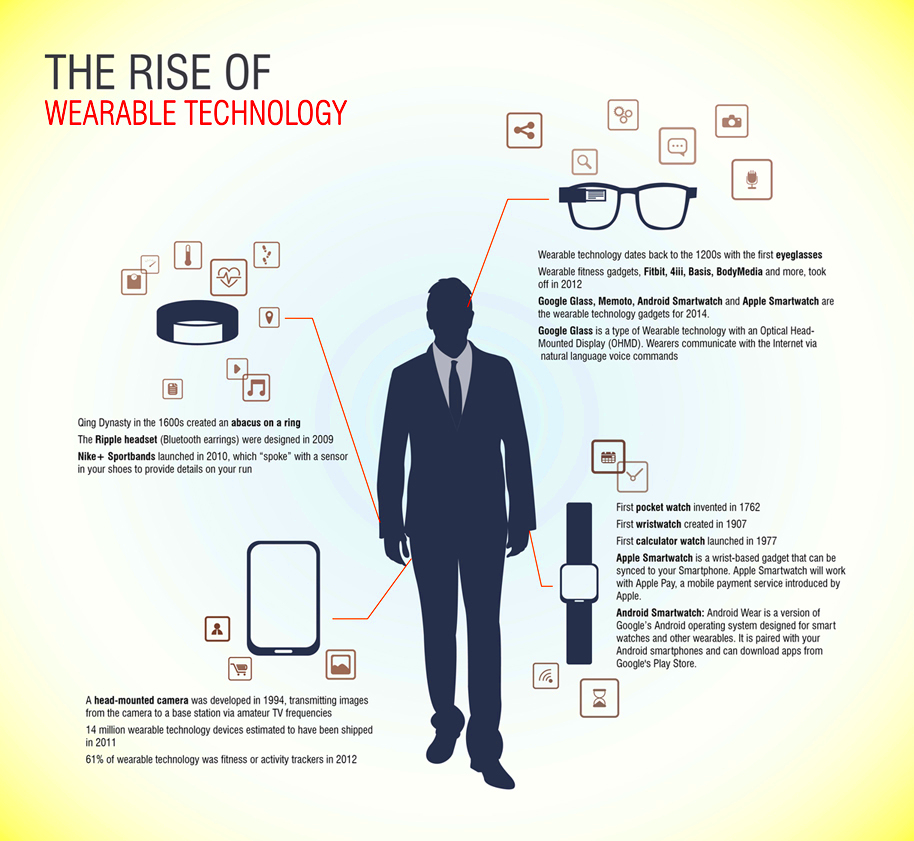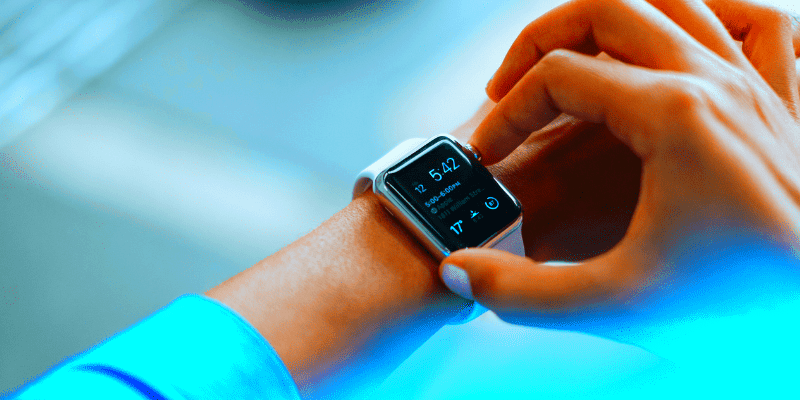The incorporation of wearable
technology into everyday life has been meteoric with the entry of companies producing innovative products that lead to improvement in living standards. These gadgets ensure communication besides providing convenience. Information dissemination, health and fitness monitoring for personal wellbeing are other functions performed by these devices.Gradually, as this particular field develops others are turning up with groundbreaking ideas making living better.
Understanding Wearable Technology

Wearable
technology is basically about clothing or pieces of jewelry containing pieces of electronic circuitry as well as microprocessors that enable them to act in a way similar to how computers do. Such gadgets may comprise multiple technologies in order to accomplish different functions such as receiving information, carrying out some actions or establishing connections with other devices. In this respect, it is possible to delineate several categories of usual wearable tech as follows:
- Smartwatches: These devices not only tell time but also track fitness, display notifications, and run apps.
- Fitness Trackers: Focused on health, these devices monitor physical activity, heart rate, and sleep patterns.
- Smart Glasses: Glasses with augmented reality capabilities provide information and visuals right in front of your eyes.
- Wearable Medical Devices: These help monitor health conditions, like insulin pumps for diabetes management.
Smart gadgets can be easily connected to smart phones or the internet making data accessible round the clock. Moreover, the introduction of new technologies has resulted in the creation of advanced technologies that are simpler to use.
Key Players in the Wearable Technology Market
Amid a flurry of growth in the wearables platform, there are notable organizations fueling its expansion. Here are a few leading lights on this scene:
| Company | Key Product(s) | Market Focus |
|---|
| Apple | Apple Watch | Health, Fitness, Communication |
| Fitbit (now part of Google) | Fitbit Charge | Fitness Tracking |
| Samsung | Galaxy Watch | Health, Fitness, Smart Features |
| Garmin | Forerunner Series | Fitness, Sports Tracking |
| Oculus (Meta) | Oculus Quest | Virtual Reality |
In addition to innovating, these businesses are also engaged in competition so as to improve user experiences. The applications for wearable technologies have a wide range, spanning health and fitness through to entertainment.
Innovations Driving Wearable Technology
It is the area of innovation that is at the heart of wearable
technology and its recent advances are making it possible to do things that were thought impossible before. Some innovations in this field include improved sensors and new materials, which are transforming the world of wearables. Here are some thrilling developments:
- Advanced Sensors: Modern wearables now come equipped with cutting-edge sensors that can monitor heart rate, blood oxygen levels, and even stress. This allows users to gain deeper insights into their health.
- AI and Machine Learning: Many devices now use AI to provide personalized recommendations based on user data. For instance, a fitness tracker can suggest workouts based on your activity level and progress.
- Flexible Displays: Innovations in materials have led to flexible displays that can conform to the body, making wearables more comfortable and stylish.
- Integration with Smart Home Devices: Wearables can now control smart home systems. Imagine adjusting your thermostat or lighting with a simple gesture on your smartwatch!
Such innovations improve their features and therefore draw more people towards wearing them. As it advances, we can anticipate even more interesting updates in the future.
Impact of Wearable Technology on Health and Fitness
There is a significant and lasting effect of wearable
technology on our health and fitness. This equipage gives individuals an opportunity to manage their health like never before. Some of the most essential advantages include:
- Real-Time Health Monitoring: Wearables provide real-time data on various health metrics, such as heart rate and sleep quality, allowing users to make informed decisions.
- Motivation to Stay Active: Many wearables come with features that encourage users to move more, like step counts and reminders to stand or walk.
- Goal Setting and Tracking: Users can set fitness goals and track their progress over time, making it easier to stay committed to a healthier lifestyle.
- Telehealth Integration: Some wearables allow for remote health monitoring, enabling doctors to access patient data and provide feedback without in-person visits.
These abilities make wearables much more than mere gadgets but also imply they can be claimed as necessary devices for bettering the wellness and fitness levels of users.
Challenges Facing Wearable Technology Companies
The manufacturers of wearable tech still encounter a series of challenges in the industry regardless of their thrilling progressions. It is vital to take care of these obstacles if one wants to keep growing and innovating consistently. Some of the key issues are:
- Data Privacy Concerns: Users are increasingly worried about how their health data is collected and used. Companies must prioritize security and transparency to build trust.
- Battery Life: As features expand, so does the demand for battery power. Users want devices that last longer without frequent charging.
- Market Saturation: The wearable tech market is becoming crowded, making it difficult for new players to stand out. Differentiation is key.
- Interoperability Issues: Many devices do not work seamlessly with one another, causing frustration for users who want a cohesive experience.
In order to prosper in this shifting environment, it is vital for organizations to overcome such obstacles. While addressing them hints at a bright future for wearable tech.
The Future of Wearable Technology in the USA
The US has a brilliant future for wearable
technology with numerous possibilities. In addition to this, as the advancement of
technology continues, it’s possible that wearables will play an even larger role in our lives. Some trends and predictions that lead us to such an exciting future include:
- Increased Health Monitoring: Wearables will offer even more health tracking capabilities, such as continuous glucose monitoring and advanced heart health analytics, enabling users to manage their health proactively.
- Enhanced Integration with AI: The integration of AI will allow wearables to learn from user behavior, providing personalized insights and recommendations tailored to individual lifestyles.
- Fashionable Designs: As demand for wearables grows, expect to see a wider variety of stylish options. Companies will focus on aesthetics, making wearables not just functional but also fashionable.
- Focus on Mental Health: Future wearables will likely incorporate features for mental well-being, such as stress management tools, mindfulness reminders, and guided meditation sessions.
- 5G Connectivity: With the rollout of 5G networks, wearables will benefit from faster and more reliable connectivity, enhancing features like real-time data sharing and improved communication.
Those trends indicate that we will always have new solutions for our daily needs through an enhancement in our lifestyles with wearables.
FAQs about Wearable Technology
During the rise of wearables, there has been an increase in people’s queries concerning the operation, advantages as well as disadvantages of this technology. The following are some of the common questions asked:
| Question | Answer |
|---|
| What is wearable technology? | Wearable technology includes electronic devices worn on the body that collect and share data. |
| How does wearable tech track my health? | Wearables use sensors to monitor various health metrics, such as heart rate, steps, and sleep patterns. |
| Can I use wearables without a smartphone? | Some devices can function independently, but many require a smartphone for full functionality. |
| Are wearables safe to use? | Yes, but it's essential to ensure data privacy and choose reputable brands that prioritize user safety. |
| How can I choose the right wearable? | Consider your specific needs, budget, and desired features when selecting a wearable device. |
This Frequently Asked Questions section points out some usual problems and questions that can assist potential consumers in making educated selections when incorporating wearable devices.
Conclusion on the Rise of Wearable Technology
To summarize, the growth of wearable technology signifies a changing pattern in the way we engage with our health, fitness and the environment that surrounds us. With ongoing advancements in technology and user-centered design, wearables will continue to become more ingrained into our lives. They enable people to track their wellness, pursue fitness targets and maintain communications which seemed impossible before.Following ahead it will be essential for organizations to tackle issues such as privacy of information and market oversaturation among others. This is important so that wearable devices can still be helpful and suitable into the future. There is much more that wearable technology can do than what we have achieved so far; the future has innumerable possibilities. If everyone supports this trend, they will live healthier lives with better connectivity options.
 Wearable technology is basically about clothing or pieces of jewelry containing pieces of electronic circuitry as well as microprocessors that enable them to act in a way similar to how computers do. Such gadgets may comprise multiple technologies in order to accomplish different functions such as receiving information, carrying out some actions or establishing connections with other devices. In this respect, it is possible to delineate several categories of usual wearable tech as follows:
Wearable technology is basically about clothing or pieces of jewelry containing pieces of electronic circuitry as well as microprocessors that enable them to act in a way similar to how computers do. Such gadgets may comprise multiple technologies in order to accomplish different functions such as receiving information, carrying out some actions or establishing connections with other devices. In this respect, it is possible to delineate several categories of usual wearable tech as follows:
 admin
admin








